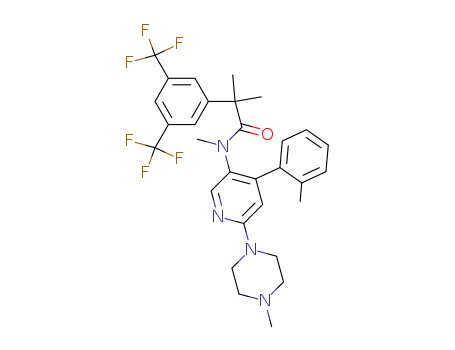- Chemical Name:Netupitant
- CAS No.:290297-26-6
- Molecular Formula:C30H32 F6 N4 O
- Molecular Weight:578.601
- Hs Code.:
- UNII:7732P08TIR
- DSSTox Substance ID:DTXSID50183271
- Nikkaji Number:J2.298.344J
- Wikipedia:Netupitant
- Wikidata:Q19598139
- NCI Thesaurus Code:C96745
- RXCUI:1552337
- Pharos Ligand ID:6LMXFPUU1DUH
- Metabolomics Workbench ID:152108
- ChEMBL ID:CHEMBL206253
- Mol file:290297-26-6.mol
Synonyms:2-(3,5-bis(trifluoromethyl)phenyl)-N,2-dimethyl-N-(4-(2-methylphenyl)-6-(4-methylpiperazin-1-yl)pyridin-3-yl)propanamide;2-(3,5-bis(trifluoromethyl)phenyl)-N-methyl-N-(4-(2-methylphenyl)-6-(4-methylpiperazin-1-yl)pyridin-3-yl)-2-methylpropanamide;benzeneacetamide, N, alpha, alpha-trimethyl-N-(4-(2-methylphenyl)-6-(4-methyl-1-piperazinyl)-3-pyridinyl)-3,5-bis(trifluoromethyl)-;benzeneacetamide, N, alpha,alpha-trimethyl-N-(4-(2-methylphenyl)-6-(4-methyl-1-piperazinyl)-3-pyridinyl)-3,5-bis(trifluoromethyl)-, hydrochloride (1:2);netupitant;netupitant dihydrochloride;netupitant hydrochloride;RO 67-3189 000;RO 673189000;RO-67-3189;RO-67-3189 000;RO-673189000





